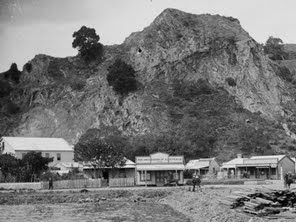Te Kooti’s Murderous Raid on Whakatane
Innocents slaughtered as Te Kooti raids Whakatane district for supplies and weaponry.
In “Frontier” Gavin Maxwell says that in March 1869, two months after his disaster at Ngatapa, Te Kooti “sought to reinforce and re-arm his followers...to swell their ranks with recruits from the Tuhoe” of the Whakatane area. p.262
Judith Binney’s view is:” “Success would breed success...and those who wavered out of fear would be driven to join him.” p.156 "Redemption Songs"
And so the Ringatu descended from their mountain fastness of the Urewera and cruelly smote the peaceful settlements on the plain. The ensuing slaughter of Maori innocents “reinforced the bitter resentment of him among Maori, and ensured that their pursuit of him would be relentless. One of the principal reasons behind Te Kooti’s fall was that he would not, or could not, call a halt to the slaughter of his own people.” Maxwell p.262
This blog is intended as a guide to historical sites, rather than providing detailed historical information (which can be read in the many history books), so below are only brief details of the episode - with the photographs I took on-site (plus maps).
On their way to Whakatane, where there was a small European town, some 400 Ringatu and Tuhoe simultaneously attacked the flour mill at Te Poronu on the banks of the Whakatane River, and the Ngati Pukeko pa of Rauporoa a short distance away, on 9 March. While these conflicts continued the next day a group of Ringatu ransacked and burned the now-deserted Whakatane.
Te Poronu Mill
The French miller, Jean Guerren and his extended Maori family unsuccessfully fought to the death to defend the mill from the attackers. A monument beside State Highway 2 four km south of Whakatane, on the right travelling south commemorates the battle at Te Poronu mill. A millstone (not the original) is set in concrete above a brass plaque which reads:
ERECTED TO THE MEMORY
OF A GALLANT SON OF FRANCE
JEAN GUERREN
WHO DIED MARCH 11 1869
HEROICALLY DEFENDING THE TE PORONU MILL
ON THIS SITE, AGAINST THE REBEL FORCES
UNDER PEKA MARAINI, LIEUTENANT OF THE
MAORI INSURGENT LEADER, TE KOOTI
ERECTED BY Y SQUADRON
Rauporoa Pa
Although besieged by a superior well-armed force the inhabitants of the pa were able to fend off the attack and most of them were able to escape north towards Matata.
The site is on private land. Nothing is visible from the land or the air.
Tauranga
 | ||
Above - on Rewatu Road looking north, approximately opposite (westwards of) the mill memorial.
Below - looking east towards the mill memorial and the river. Rauporoa pa was in this vicinity.
Tauranga
After sacking and burning the small (deserted) town, the Ringatu Some of the Ringatu force, including Te Kooti, remained at Whakatane until government relief parties arrived. They then moved southwards with their booty and captives, pursued for a while by troops under William Mair, until they were able to make their escape back into the Urewera.
The buildings of Whakatane were under Puketapu Lookout on what is now The Strand, with Canning Place as a service entrance behind them.
Below - the listing of the pa site on "Fortifications of the New Zealand Wars" by Nigel Prickett.
 |
| Whakatane 1910. In 1869 it looked very similar. |
 |
| The site of the old town in 2019 |
 | ||||
| Site of the mill and the pa |
Below - the listing of the pa site on "Fortifications of the New Zealand Wars" by Nigel Prickett.
Download the complete file at:










Comments
Post a Comment